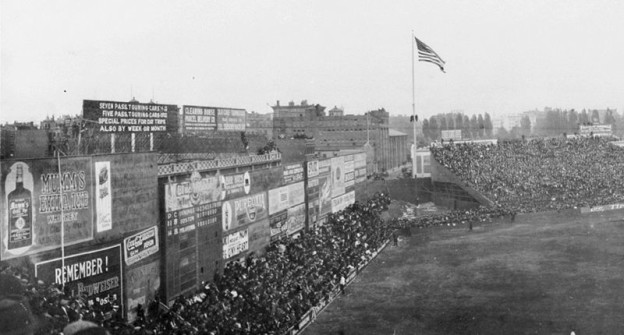Wooden Bleachers: 1912-1926
Wooden bleachers occupied the left-field foul territory until 1926, when they burned down in a fire. Boston owner Bob Quinn, strapped for cash, collected the insurance money and, rather than rebuild, used the windfall to make payroll. The team removed the charred remains and the area where the bleachers once occupied remained a vacant lot for several years, a prominent yet unsightly feature of the park. It wasn’t until 1934, when new owner Tom Yawkey ordered major renovations to the ballpark, that the eyesore was eliminated.
Duffy’s Cliff: 1912-1933
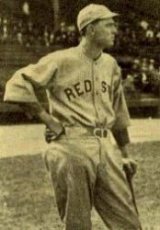
Duffy’s Cliff was a ten-foot-high mound that formed an incline in front of the left field wall from the day the park opened in 1912 until the 1933 season. It extended from the left field foul pole over to the left field flag pole and was originally built to allow standing-room crowds to see over each other’s heads during play (it was not uncommon in those days for overflowing crowds to be seated just a few feet inside the foul poles and, in the time known as the Dead Ball Era, it was rare for balls to travel that far into the outfield).
This feature was named in honor of Red Sox outfielder Duffy Lewis, a member of three world championship teams between 1912 and 1916, who mastered the incline during his tenure in Boston. Sports cartoons of the period often depicted the celebrated fly-catcher as a mountain climber making catches amid sheep and snow caps. The mound was reduced in 1934 as part of Yawkey’s renovations and was eventually eliminated completely when the entire field was dug up and replaced following the 2004 season to improve drainage, among other reasons.
Center Field Flag Pole: 1912-1970
Up until it was moved off the playing field in 1970, the flagpole in center field, located between the Green Monster and the left field bleacher seats, was not closed in and any ball hit off this object was in fair play. Directly behind this pole was a very tricky double angled wall; the few times a year that someone would actually hit one there, it made for some wild play. In 1970, the pole was enclosed and removed from the field of play; the original base of the pole and the distance marker are still visible inside the Bleacher Bar, which may be accessed from Lansdowne Street.
On 13 July 2009, in recognition of the passing of Red Sox legend Dom DiMaggio in May 2009, the pole was named in honor of the seven-time All-Star, who was a center field fixture at Fenway Park from 1940 until 1952, save for three years missed due to his service during World War II.
“Tin” Monster: 1934-1975
Tin covered the left field wall between 1934 and 1975 and had the distinction of creating problems for outfielders. The framework for the wall was made from 2-by-4s, and if the ball struck the stud, it had a nice live bounce. However, balls that struck the wall between the studs merely dropped straight down as the tin absorbed most of the impact. After Red Sox rookie outfielder Fred Lynn crashed hard into the base of the wall during the 1975 World Series, it was rebuilt during the following off-season out of hard plastic and six-foot-tall crash pads were installed at the base of the wall to minimize the risk of further injury.
Green Monster Netting: 1936-2002
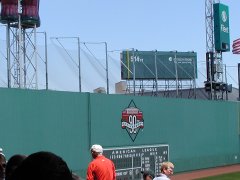
To protect the windows of businesses on Lansdowne Street, the Red Sox erected a 23-foot-high net that stretched the entire length above the left field wall in 1936. This simple barrier remained in place until the Monster Seats were erected following the 2002 season.
To retrieve balls hit into the netting after a game, groundskeepers would scale a ladder affixed to the wall that extended above the upper-left portion of the manual scoreboard, 13 feet above the ground, to the top of the wall. The ladder remains in place as the sole reminder of what was and, as before, any ball that strikes it remains in play.
In connection with this, a story circulated for several years starting in the late 1990s that Fenway was the only ball park in Major League Baseball that included a ruling for a ground-rule triple in its ground rules. The belief was that any batted ball that struck the ladder during play would result in the batter being awarded three bases.
Most agree that it was Boston-area television sports reporters who originated the myth, which gained further credibility when it was repeated by several respected online sources. However, according to ground rules listed at the official online site for the Red Sox at the time, there was no mention of a ground-rule triple, making it nothing more than a tall tale.
406 Club: 1988-2005
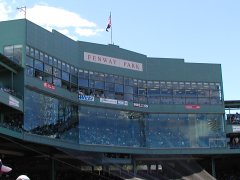
In 1988, an enclosed section of seats were built high above home plate and were referred to as the 600 Club. This exclusive VIP seating offered fine dining and a private bar — no blue jeans allowed — as well as stadium-style theater seating where you would enjoy possibly the best view of the park. Oddly enough, sounds of the game like the crack of the bat and the roar of the crowd were piped in through speakers, as the glass also served to muffle this aspect of a day at the park.
After legendary Red Sox player Ted Williams passed away in the summer of 2002, the franchise decided to rename this feature of Fenway to the .406 Club in honor of the most recognized name in Red Sox history. This was in recognition of Williams, who finished with a .406 batting average in 1941, being the last player in major league history to hit better than .400 for a season. Following the 2005 season, the 406 Club fell victim to renovations being orchestrated by the new ownership and was replaced by open-air premium pavilion level seating areas, including the EMC Club.
Coke Bottles: 1997-2007
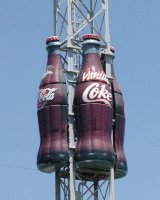
For years after Yawkey’s death in 1976, ownership stayed true to his wishes that Fenway Park should not get splattered with advertisements around every corner, but a very large and prominent feature took center stage in 1997 when over-sized Coca-Cola bottles were added to one of the light towers above the Green Monster. Diehard baseball purists initially howled in protest but they soon become a recognized feature of the park. Sluggers took the opportunity not only to knock one over the Monster but to strike a towering shot off the bottles. Over time, the bottles would change to reflect the marketing push of the company, but the familiar classic shape of the bottle remained a constant.
More than ten years later, as corporate sponsorships have become an integral part of the team’s revenue stream, large-scale ads like the bottles have become more prominent at Fenway Park, though the new ownership has made efforts to keep the distraction to a minimum. Following the 2007 season, these bottles were removed and a new section of Fenway debuted in the upper deck in left field named the “Coca-Cola Corner.”
Conigliaro’s Corner: 2007-2008
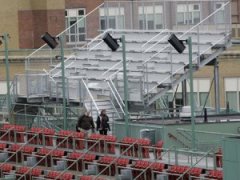
Less than a week before the 2007 season, the Red Sox announced the addition of a new section of seating on the right field roof deck at Fenway Park named Conigliaro’s Corner. Tony Conigliaro, of course, was a native son of Boston and a promising young right fielder for the Red Sox who was struck by an errant pitch in August of 1967, just over a month before Boston won its first pennant in 21 years to conclude the “Impossible Dream” season. Available only for purchase prior to game time, the 200 seats were marketed specifically towards families and cost $25 each to match the number worn by Conigliaro during his days with Boston. Never meant to become a permanent fixture, this section was removed after the 2008 season.
